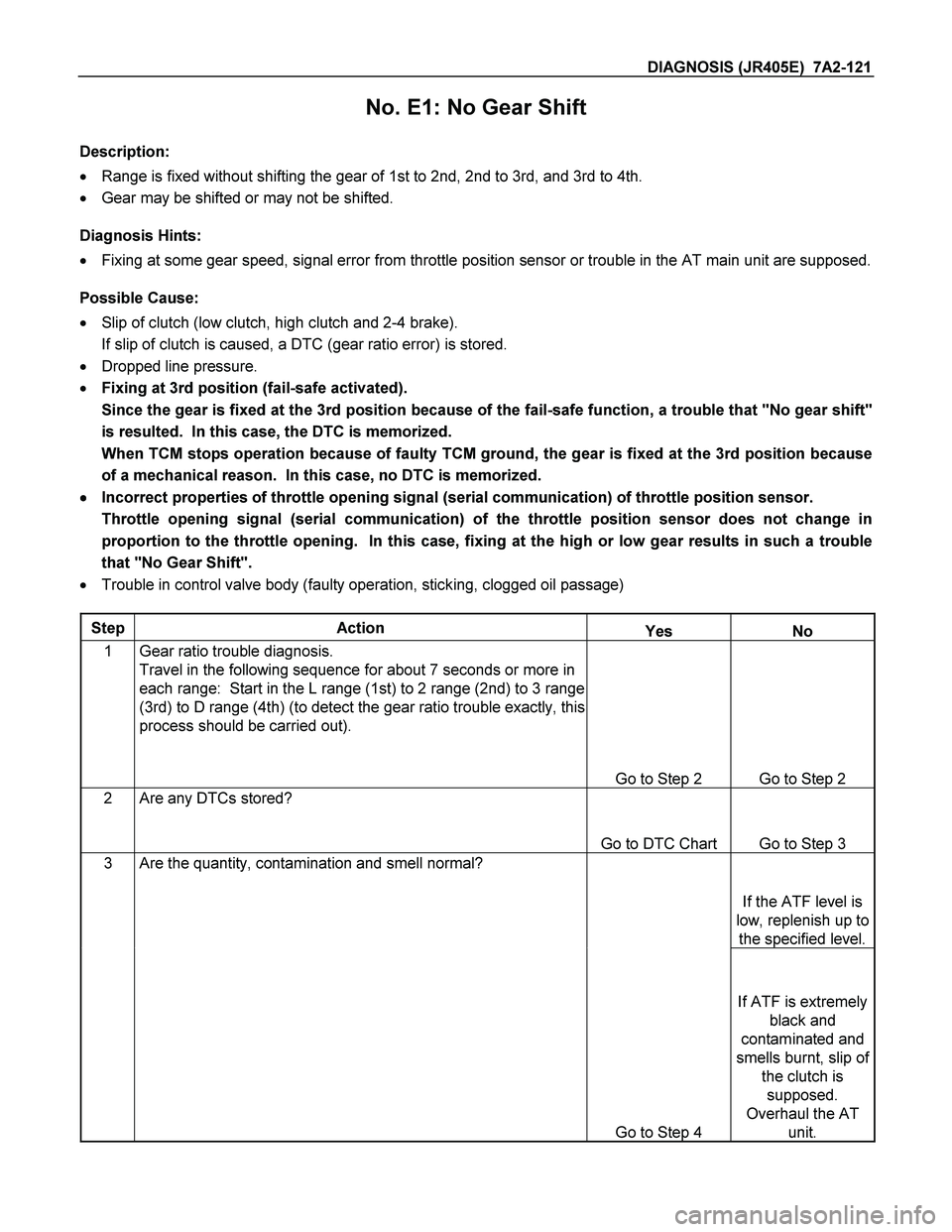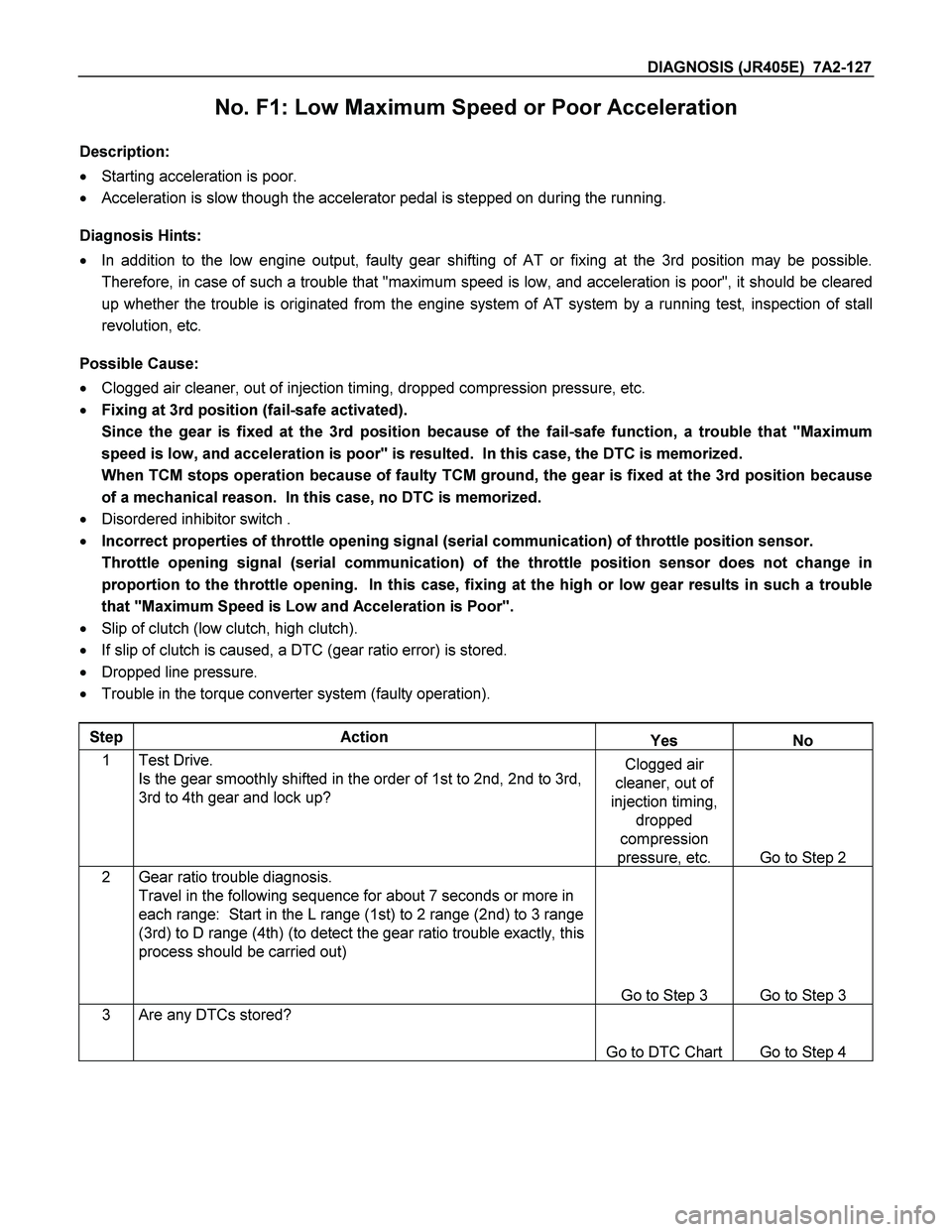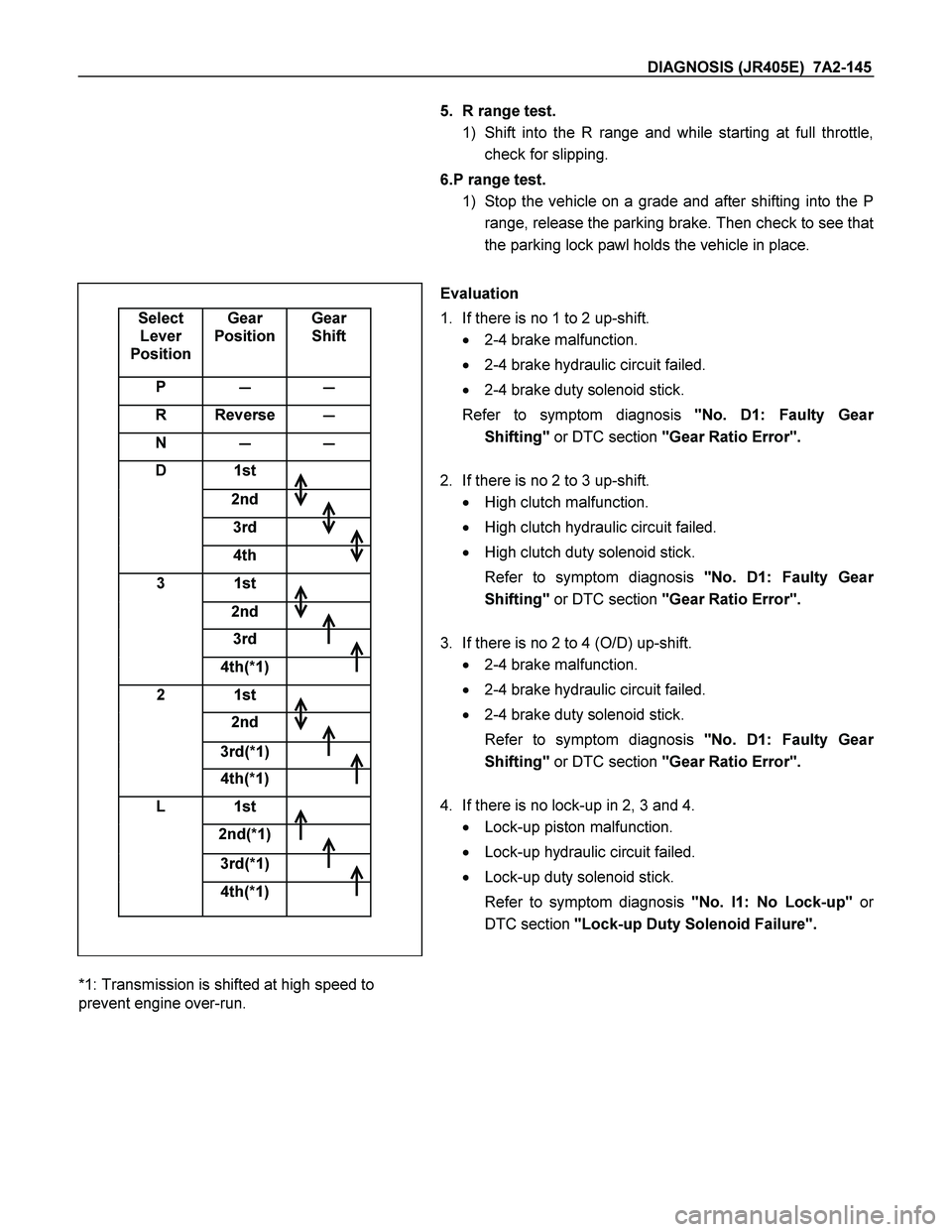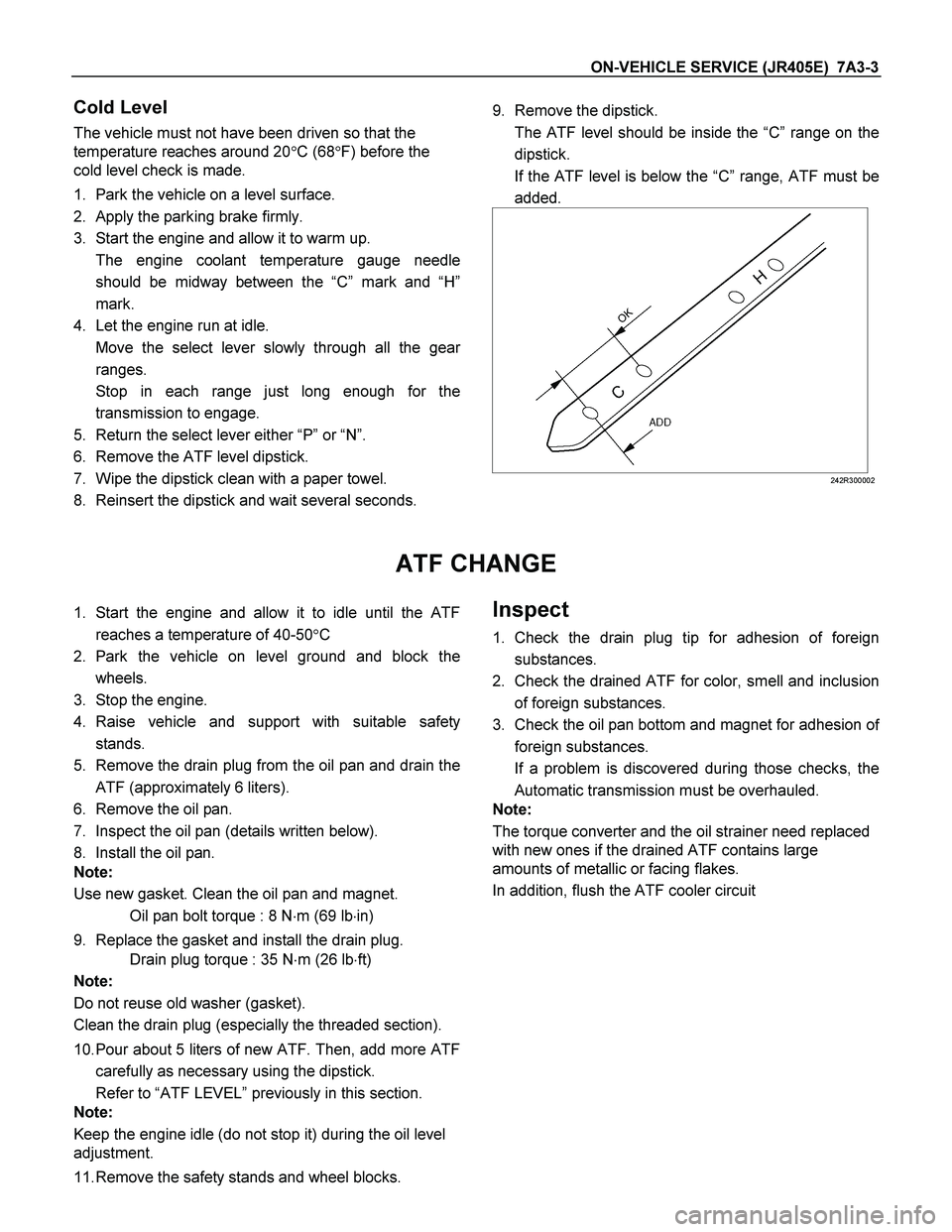Page 4113 of 4264

DIAGNOSIS (JR405E) 7A2-121
No. E1: No Gear Shift
Description:
� Range is fixed without shifting the gear of 1st to 2nd, 2nd to 3rd, and 3rd to 4th.
� Gear may be shifted or may not be shifted.
Diagnosis Hints:
� Fixing at some gear speed, signal error from throttle position sensor or trouble in the AT main unit are supposed.
Possible Cause:
� Slip of clutch (low clutch, high clutch and 2-4 brake).
If slip of clutch is caused, a DTC (gear ratio error) is stored.
� Dropped line pressure.
� Fixing at 3rd position (fail-safe activated).
Since the gear is fixed at the 3rd position because of the fail-safe function, a trouble that "No gear shift"
is resulted. In this case, the DTC is memorized.
When TCM stops operation because of faulty TCM ground, the gear is fixed at the 3rd position because
of a mechanical reason. In this case, no DTC is memorized.
�
�� � Incorrect properties of throttle opening signal (serial communication) of throttle position sensor.
Throttle opening signal (serial communication) of the throttle position sensor does not change in
proportion to the throttle opening. In this case, fixing at the high or low gear results in such a trouble
that "No Gear Shift".
� Trouble in control valve body (faulty operation, sticking, clogged oil passage)
Step Action Yes No
1 Gear ratio trouble diagnosis.
Travel in the following sequence for about 7 seconds or more in
each range: Start in the L range (1st) to 2 range (2nd) to 3 range
(3rd) to D range (4th) (to detect the gear ratio trouble exactly, this
process should be carried out).
Go to Step 2 Go to Step 2
2 Are any DTCs stored?
Go to DTC Chart Go to Step 3
3 Are the quantity, contamination and smell normal?
If the ATF level is
low, replenish up to
the specified level.
Go to Step 4
If ATF is extremely
black and
contaminated and
smells burnt, slip of
the clutch is
supposed.
Overhaul the AT
unit.
Page 4119 of 4264

DIAGNOSIS (JR405E) 7A2-127
No. F1: Low Maximum Speed or Poor Acceleration
Description:
� Starting acceleration is poor.
� Acceleration is slow though the accelerator pedal is stepped on during the running.
Diagnosis Hints:
� In addition to the low engine output, faulty gear shifting of AT or fixing at the 3rd position may be possible.
Therefore, in case of such a trouble that "maximum speed is low, and acceleration is poor", it should be cleared
up whether the trouble is originated from the engine system of AT system by a running test, inspection of stall
revolution, etc.
Possible Cause:
� Clogged air cleaner, out of injection timing, dropped compression pressure, etc.
� Fixing at 3rd position (fail-safe activated).
Since the gear is fixed at the 3rd position because of the fail-safe function, a trouble that "Maximum
speed is low, and acceleration is poor" is resulted. In this case, the DTC is memorized.
When TCM stops operation because of faulty TCM ground, the gear is fixed at the 3rd position because
of a mechanical reason. In this case, no DTC is memorized.
� Disordered inhibitor switch .
� Incorrect properties of throttle opening signal (serial communication) of throttle position sensor.
Throttle opening signal (serial communication) of the throttle position sensor does not change in
proportion to the throttle opening. In this case, fixing at the high or low gear results in such a trouble
that "Maximum Speed is Low and Acceleration is Poor".
� Slip of clutch (low clutch, high clutch).
� If slip of clutch is caused, a DTC (gear ratio error) is stored.
� Dropped line pressure.
� Trouble in the torque converter system (faulty operation).
Step Action Yes No
1 Test Drive.
Is the gear smoothly shifted in the order of 1st to 2nd, 2nd to 3rd,
3rd to 4th gear and lock up?
Clogged air
cleaner, out of
injection timing,
dropped
compression
pressure, etc. Go to Step 2
2 Gear ratio trouble diagnosis.
Travel in the following sequence for about 7 seconds or more in
each range: Start in the L range (1st) to 2 range (2nd) to 3 range
(3rd) to D range (4th) (to detect the gear ratio trouble exactly, this
process should be carried out)
Go to Step 3 Go to Step 3
3 Are any DTCs stored?
Go to DTC Chart Go to Step 4
Page 4137 of 4264

DIAGNOSIS (JR405E) 7A2-145
5. R range test.
1) Shift into the R range and while starting at full throttle,
check for slipping.
6.P range test.
1) Stop the vehicle on a grade and after shifting into the P
range, release the parking brake. Then check to see tha
t
the parking lock pawl holds the vehicle in place.
Select
Lever
Position
Gear
Position
Gear
Shift
P �
�� � �
�� �
R Reverse �
�� �
N �
�� � �
�� �
D 1st
2nd
3rd
4th
3 1st
2nd
3rd
4th(*1)
2 1st
2nd
3rd(*1)
4th(*1)
L 1st
2nd(*1)
3rd(*1)
4th(*1)
Evaluation
1. If there is no 1 to 2 up-shift.
� 2-4 brake malfunction.
� 2-4 brake hydraulic circuit failed.
� 2-4 brake duty solenoid stick.
Refer to symptom diagnosis "No. D1: Faulty Gea
r
Shifting" or DTC section "Gear Ratio Error".
2. If there is no 2 to 3 up-shift.
� High clutch malfunction.
� High clutch hydraulic circuit failed.
� High clutch duty solenoid stick.
Refer to symptom diagnosis "No. D1: Faulty Gea
r
Shifting" or DTC section "Gear Ratio Error".
3. If there is no 2 to 4 (O/D) up-shift.
� 2-4 brake malfunction.
� 2-4 brake hydraulic circuit failed.
� 2-4 brake duty solenoid stick.
Refer to symptom diagnosis "No. D1: Faulty Gea
r
Shifting" or DTC section "Gear Ratio Error".
4. If there is no lock-up in 2, 3 and 4.
� Lock-up piston malfunction.
� Lock-up hydraulic circuit failed.
� Lock-up duty solenoid stick.
Refer to symptom diagnosis "No. I1: No Lock-up"o
r
DTC section "Lock-up Duty Solenoid Failure".
*1: Transmission is shifted at high speed to
prevent engine over-run.
Page 4155 of 4264

ON-VEHICLE SERVICE (JR405E) 7A3-3
Cold Level
The vehicle must not have been driven so that the
temperature reaches around 20�C (68�F) before the
cold level check is made.
1. Park the vehicle on a level surface.
2. Apply the parking brake firmly.
3. Start the engine and allow it to warm up.
The engine coolant temperature gauge needle
should be midway between the “C” mark and “H”
mark.
4. Let the engine run at idle.
Move the select lever slowly through all the gea
r
ranges.
Stop in each range just long enough for the
transmission to engage.
5. Return the select lever either “P” or “N”.
6. Remove the ATF level dipstick.
7. Wipe the dipstick clean with a paper towel.
8. Reinsert the dipstick and wait several seconds.
9. Remove the dipstick.
The ATF level should be inside the “C”range on the
dipstick.
If the ATF level is below the “C” range, ATF must be
added.
242R300002
ATF CHANGE
1. Start the engine and allow it to idle until the ATF
reaches a temperature of 40-50�C
2. Park the vehicle on level ground and block the
wheels.
3. Stop the engine.
4. Raise vehicle and support with suitable safety
stands.
5. Remove the drain plug from the oil pan and drain the
ATF (approximately 6 liters).
6. Remove the oil pan.
7. Inspect the oil pan (details written below).
8. Install the oil pan.
Note:
Use new gasket. Clean the oil pan and magnet.
Oil pan bolt torque : 8 N�m (69 lb�in)
9. Replace the gasket and install the drain plug.
Drain plug torque : 35 N�m (26 lb�ft)
Note:
Do not reuse old washer (gasket).
Clean the drain plug (especially the threaded section).
10. Pour about 5 liters of new ATF. Then, add more ATF
carefully as necessary using the dipstick.
Refer to “ATF LEVEL” previously in this section.
Note:
Keep the engine idle (do not stop it) during the oil level
adjustment.
11. Remove the safety stands and wheel blocks. Inspect
1. Check the drain plug tip for adhesion of foreign
substances.
2. Check the drained ATF for color, smell and inclusion
of foreign substances.
3. Check the oil pan bottom and magnet for adhesion o
f
foreign substances.
If a problem is discovered during those checks, the
Automatic transmission must be overhauled.
Note:
The torque converter and the oil strainer need replaced
with new ones if the drained ATF contains large
amounts of metallic or facing flakes.
In addition, flush the ATF cooler circuit